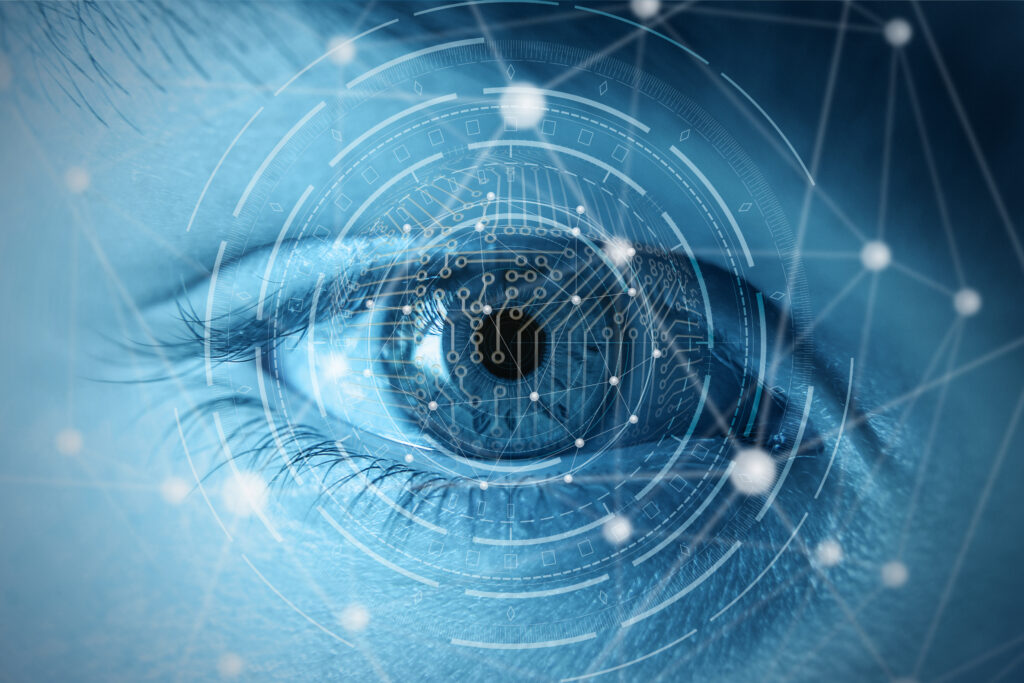
Vision is something many don’t think about until it’s too late. You may think glasses are the solution to your vision problems, but many eye conditions require direct medical intervention in the form of invasive surgeries and procedures.
Want to try something different? What would you say to a treatment option that may even completely restore your vision without surgery? It’s time to harness the power of microcurrent eye therapy! Since the 1990s, microcurrent eye therapy has shown promising results and has only increased efficiency with the advent of new technology. Our patients typically report outstanding results, some experiencing vision improvement after only one session of microcurrent eye therapy.
Here, we’ve compiled some of the most compelling and helpful information on maintaining eye health and our approach to treating eye conditions for you all in one place!
The Trinity of Eye Health- Our Philosophy
It’s important to understand that we approach wellness differently from conventional medicine. We look at the whole body, and treat health problems holistically. Our approach integrates concepts from ancient medicine with cutting-edge technology to create breakthrough treatments and protocols that are helping thousands of people across the world.
We’ve identified three major contributing factors that support optimum eye health.
These are:
- Nutrition
- Blood flow
- Electrical potential
Like the three legs of a stool, these three factors work together to support the health of the eye. By taking measures to follow this The Trinity of Eye Health, we believe you will be able to reverse eye disease and restore your vision naturally, without resorting to invasive medical intervention.
Eye Health Pillar #1: Nutrition for the Eyes

What you eat each day fuels your body, and it’s essential to consider your diet when you are experiencing vision problems. The following vitamins and nutrients support eye health:
- Vitamin B
- Antioxidants (such as Selenium)
- Vitamin C
- Omega-3 Fatty Acids
- Vitamin E
- Zinc Oxide
- Copper Oxide
If you are looking to maintain or correct vision issues, supplementation is an important step you can take to support those goals. When the body has enough of these vitamins and nutrients, the eye is able to keep its structure healthy and strong. In studies of people already suffering from symptoms of eye deterioration, simply consuming the appropriate quantities of these nutrients reduced their chances of vision loss by 25%!
For everything you need to protect your eyes, all in one place, check out our Sana Therapeutics Eye Health Support Kit! This bundle has been specially curated to provide the essential nutrients required to feed the eye and maintain optimal health. These supplements are formulated to:
- Provide antioxidants for the maintenance of eye health.
- Help to reduce the risk of developing cataracts.
- Help to improve macular pigment optical density.
- Help to support eye health in conditions such as cataracts and age-related macular degeneration.
The amino acids and the taurine in the Prorine are essential for eye health, and when combined with the Lutein and Zeaxanthine in the Lut-Zea Vision, you’ve got full-spectrum support for the eye.
Eye Health Pillar #2: Proper Blood Flow
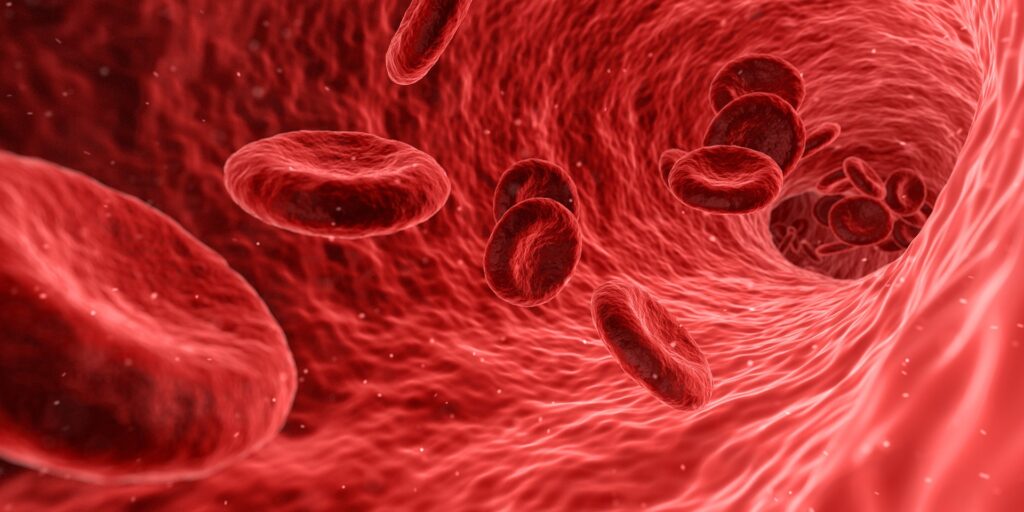
Blood flow is imperative to keeping the body healthy and functioning. Without adequate blood flow to an area of the body, it will die. Conversely, increasing blood flow to a damaged area increases the boy’s ability to restore itself.
How does this work? White blood cells fight off infection, and red blood cells deliver much-needed oxygen that will form the energy basis for healing and halting degeneration.
Things like heat treatments, ice, and exercise can increase blood flow to most of the rest of the body. But how do you increase blood flow to the eye itself? Luckily, a number of microcurrent protocols act like vasodilators, increasing blood flow to the eyes, thus promoting healing.
Eye Health Pillar #3: Electrical Potential
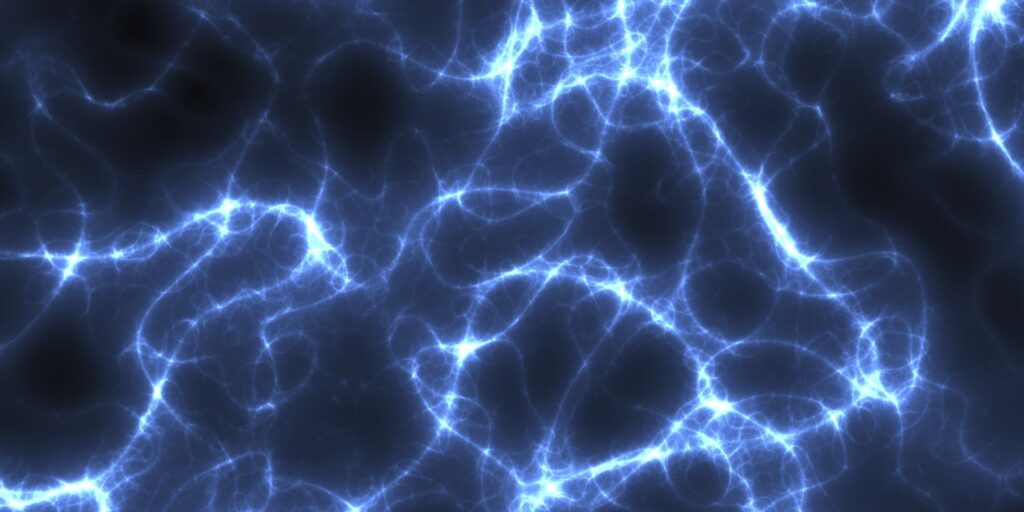
Electric potential is the amount of energy it takes to move a charged particle from one point to another within an electric field. When you are sick or suffer from nutrient deficiency, the electrical potential of your cells will decay, hindering reparative activity. In order to continue to make new cells that work, a healthy cell must maintain a voltage of -25 millivolts while simultaneously retaining the ability to rise to -50 millivolts on demand to allow for cellular repair to take place.
Microcurrent therapy offers a simple, noninvasive way to maintain the electrical potential of the cells in your eyes. Through the stimulation of your cells, you can restore that electrical potential and ensure the cells within the eye are functioning as they should, halting degeneration.
This integrated approach to eye health functions by building a foundation of appropriate nutrients, ensuring proper oxygenation, and ensuring the electrical potential of your eyes through microcurrent therapy.
How Does the Eye Work?
Your eyes are the window to the world around you. If you are wondering how your eyes work, it’s essential to know that there are several major players when it comes to eye health. When any of these critical functions are damaged, you will run into vision problems.
Rods and Cones
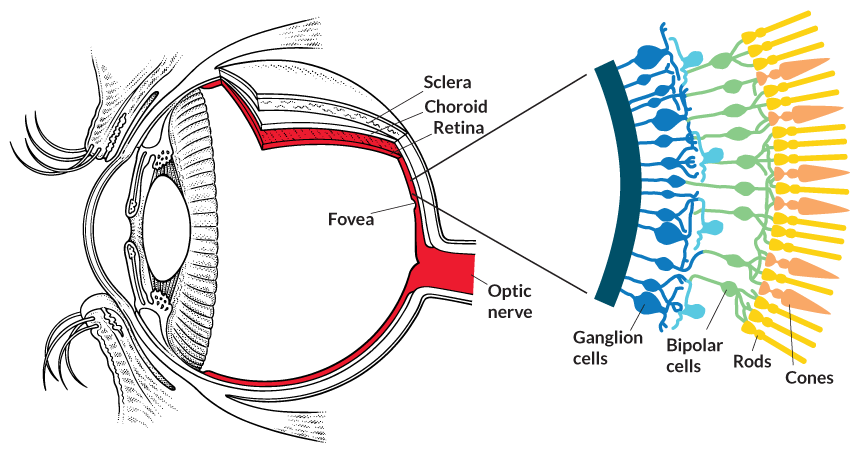
In your eye, there are photoreceptors. These cells are involved in converting light rays to electrical signals. There are two types of photoreceptors in your eye: rods and cones. They are named according to the shape of their outer segment. Each retina, located at the back of the eye, has about 120 million rods and 6 million cones!
- Rods- Are highly sensitive to light. Located near the retina’s outer edges, rods are used to help us see in low light situations. This type of photoreceptor is also used for peripheral vision.
- Cones- Cones, on the other hand, are found in the retina’s central area. Weakly photosensitive, they come into play in bright light situations. They are responsible for color vision and are principally used during the daytime.
The Fovea
The highest density of cones is found in a region of the retina called the fovea. The fovea is the part of the eye responsible for sharp, focused vision. For example, when you focus intently on an object in bright light, such as the title of a book, your eyes will adjust to project the image of the object directly onto the fovea. This sends signals to your brain to allow you to see the letters in sharp detail.
In contrast, if you are trying to see something in dim light, you may notice that you have better luck seeing the object with your peripheral vision. This is because your rods work better than your cones in low light, and they are located at the edges of the retina.
Ganglion Cells
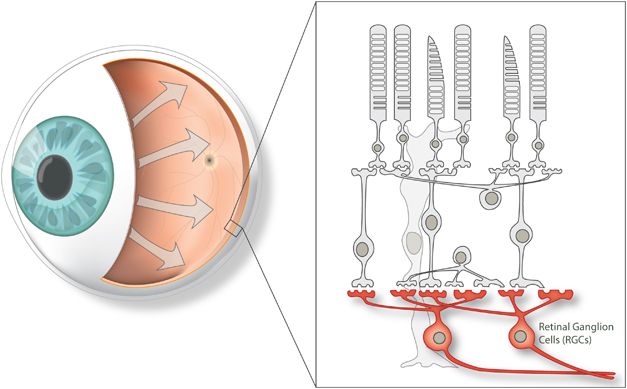
Ganglion cells work to send electronic images to the brain. The bipolar cells are like transistors that assemble images. And the cones are like antennae that receive light signals.
Muller Cells
Miller cells are the wiring system of the retina, providing voltage to the eye. They are the first cells to die in any macular disease. Muller cells are important structural cells that help maintain the stability of the macula (the central part of the retina). They help to store xanthophyll, chemical compounds that support good vision.
The Choroid
The choroid is the blood supply for the retina. Sufficient blood flow brings oxygen and nutrients to the entire retina. Therefore, most eye problems are related to oxygen and nutrient delivery or lack thereof. Increasing blood flow via the choroid is essential to good eyesight.
The Macula
The macula is composed of millions of photosensitive cone cells. These cone cells are needed for focused central vision. The macula is highly sensitive, even compared to the rest of the retina.
The Retina
The retina works by transforming light into electrical signals, which are then sent to the brain through the optic nerve. The brain then takes the messages and translates them into visual images for us to see. A damaged macula results in vision that appears dark, distorted, and blurry at the center.
Treat These Eye Conditions with Microcurrent Therapy
Microcurrent Therapy has been shown to help treat the following conditions:
- Scar Tissue- Clinically, not much thought is given to scar tissue beyond its physical appearance. Still, the issues run deep, and with eyes, the physical manifestation of the problem is even more apparent than in cases in other areas of the body. The communication network of the body relies on this electrical communication to flow correctly. Scar tissue acts as roadblocks, stopping the flow of communication and forcing the connection to either find another route or give up entirely. This leads to a lack of healing, degeneration, and long-term damage.
- Eyestrain- Eyestrain, or eye fatigue, commonly occurs in people who focus intently with their eyes for long periods. Symptoms of eyestrain include tired or sore eyes, itchy or burning sensations in the eyes, dry or watering eyes, vision changes, difficulty keeping eyes open, light sensitivity, headaches, sore muscles in the shoulders, neck, or back and problems with concentration.
- Eye Spasms- Eye spasms are involuntary twitching of the muscles connected to or near the eyes. These different types of Eye Spasms are commonly known as twitching, benign essential blepharospasm, and hemifacial spasm. Each kind of twitch or spasm has a different cause, but all can be helped by microcurrent.
- Myopia- Myopia (nearsightedness) happens due to a misshaping of the eyeball so that instead of a sphere, it becomes too long when measured front to back. This changes your vision so that the point of focus shifts in front of the retina rather than on it. As a result, a nearsighted person can see nearby objects clearly, but when the objects are farther away, they appear blurred.
- Amblyopia- Amblyopia, also known as lazy eye, is a condition in which the brain favors the use of one eye. There are several causes of amblyopia, but the result is that the weaker eye tends to turn inward or outward. It can affect both eyes, but usually only one.
- Uveitis- Uveitis is a type of inflammation of the eye, affecting the uvea, or middle layer of the eye. The uvea consists of three structures: the iris, the choroid, and the ciliary body; uveitis can involve inflammation of any or all these parts of the eye.
- Astigmatism- Astigmatism, like nearsightedness, is caused by an eye that is out of round. In this case, it causes the eye to focus light unevenly onto the retina, resulting in distorted or blurred vision. A person with astigmatism may also have farsightedness or myopia.
- Age-Related Macular Degeneration- Macular degeneration is most often found in individuals over the age of 60 and is the top cause of vision loss in this age group. For this reason, it is very often called age-related macular degeneration, or AMD for short.
While macular degeneration doesn’t usually result in complete blindness, it can impair vision to the point of true disability. Vision loss due to macular degeneration is generally considered irreversible.
- Dry Macular Degeneration- Dry macular degeneration is the most common; it typically involves some loss of vision in the central portion of the field of view.
- Cataracts- Cataracts is a clouding of the usually transparent lens of the eye. Cataracts cause the vision to cloud, like trying to see through a foggy window or glasses lens. This, of course, causes problems if you are trying to drive safely, read a book, or even your friend’s facial expression.
- Acute Glaucoma- A healthy optic nerve is necessary for good vision. Glaucoma is a term that refers to several conditions that result in damage to the optic nerve of the eye. Often (but not always, this is related to increased pressure in the eye.
Glaucoma can cause blindness, and in fact, is one of the top causes of blindness in people over 60. While more common in the elderly, glaucoma can happen at any age.
- Subconjunctival Hemorrhage- (Ruptured Blood Vessels) The conjunctiva of the eye is the thin, transparent membrane covering much of the exterior surface of the eye as well as the inner surface of the eyelids. A subconjunctival hemorrhage refers to bleeding that happens under this membrane due to the breaking of a small blood vessel, for instance, as a result of a forceful cough or sneeze. Because the conjunctiva doesn’t readily absorb blood, when this happens, the blood tends to pool under the membrane.
If you’ve ever looked in the mirror and noticed that the white of your eye has turned red, that’s likely what has happened. Despite its scary appearance, this condition is usually harmless and will typically go away on its own within a couple of weeks.
- Acute Retinal Detachment- Retinal detachment occurs when this layer dislodges from the back of the eye. When this happens, the retina becomes separated from its blood supply, which prevents it from receiving the nutrients and oxygen it needs to function correctly.
Retinal detachment is an emergency condition that can lead to permanent vision loss. Even though the condition itself is painless, it’s essential to treat it as soon as possible after it happens.
- Ocular Trauma- Trauma of the eye (orbital trauma) or the area around it (periorbital trauma) is often associated with significant eye injuries, and the ophthalmologist’s role is vital in diagnosing and initiating appropriate treatment for these injuries.
- Presbyopia- Presbyopia refers to the loss of the ability to focus on objects close to your eyes. It is caused by a natural hardening and loss of flexibility of the lens of the eye, which prevents the lens from changing shape. Presbyopia is a gradual and natural effect of the aging process.
Most people notice the first signs of presbyopia shortly after the age of 40, and it will typically progress until a person is about 65.
If you or someone you know has one of these eye conditions, what do you do? Worry not, we’ve developed protocols for treating all the previously discussed eye conditions.
If you are already suffering from vision problems, or even suspect you may be, now is the time to act. Many eye conditions only deteriorate as time goes on, and swift action is essential.
Microcurrent Products and Protocols for Eye Health
Here is a list of the top products and resources we recommend for those seeking to improved their vision with microcurrent therapy:
Microcurrent Devices for Vision Therapy
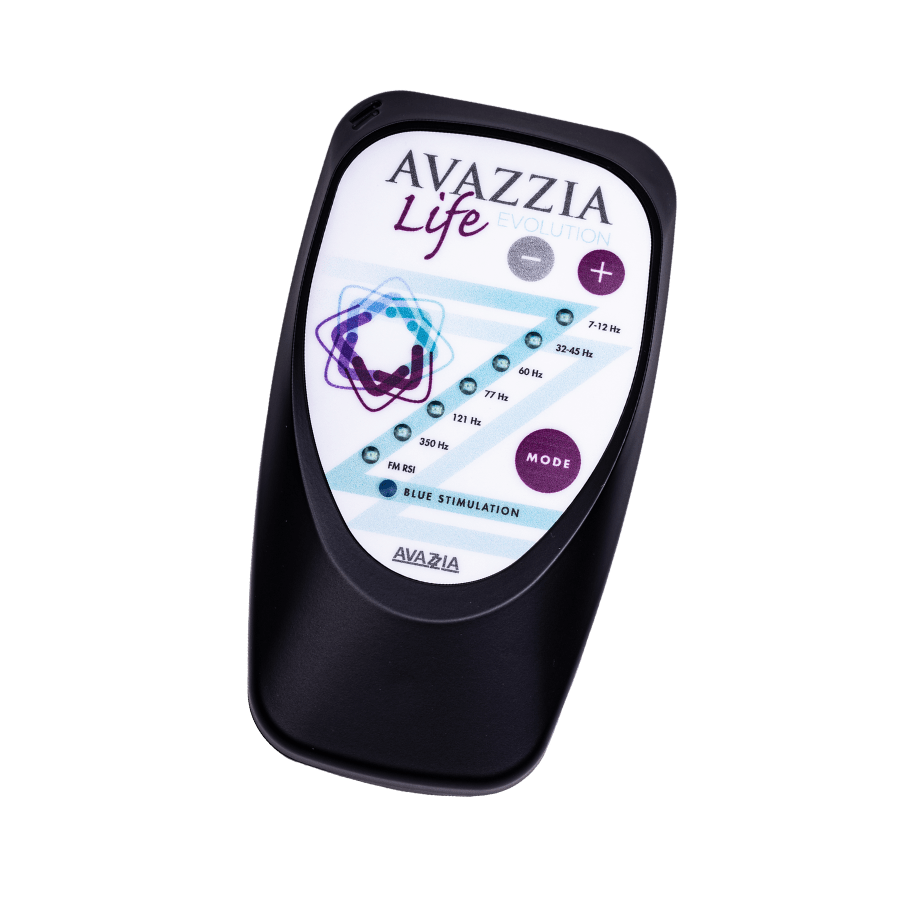
When treating the eye, we suggest you use either the Avazzia Pro Sport III or the Avazzia Life Evolution. These microcurrent devices can generate the proper frequencies needed to execute eye therapy protocols and are compatible with Microcurrent Goggles.
Avazzia Pro Sport III– Our top of the line model is used by professionals such as doctors and veterinarians and is undoubtedly the most advanced microcurrent technology available today. The Avazzia Pro Sport III is the pinnacle in microcurrent advancement—capable of tackling even the most complex health issues, like eye disease, with excellent results.
Avazzia Life Evolution- With this device, you can expect maximum functionality and ease of use for the home user. With the Avazzia Life Evolution, you can expect professional features at an affordable and accessible price. With over ver two decades of expertise in microcurrent technology and clinical applications, this device is the best home microcurrent machine available today.
Microcurrent Goggles- The 21st Century’s Best-Kept Secret to Eye Health
Microcurrent Goggles are specifically designed to hit targeted reflex points while simultaneously treating the entire eye. When used with a device like the Avazzia Pro Sport III or the Avazzia Life Evolution, Microcurrent Goggles stimulate key points around the eye, while delivering the current directly into the eye itself. Simply closes your eyes, apply the goggles, and the gentle current is delivered through the eyelid. No pain, no surgery, no recovery time.
The result is an intensified response to treatment, delivering revolutionary results. A significant benefit to this treatment is increased blood flow to the area, which provides essential nutrients to the eyes. Many patients experience a decrease in scar tissue and stimulation of cellular activity with the use of Microcurrent Goggles.
The Secrets of Eye Health Book: Microcurrent Therapy for the Eyes
The most comprehensive collection of information available on microcurrent therapy for the eyes is now available! Learn the basics of our eyes and the factors that contribute to their health and their decay. This book briefly explores the relationship between microcurrent and the eye and shows how a variety of eye conditions can be reversed with the use of correctly applied microcurrent therapy.
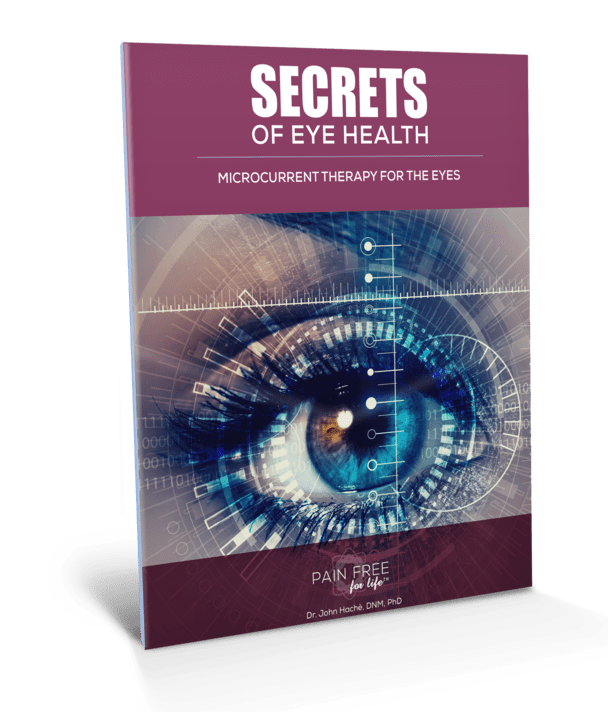
Now available in Paperback and E-book copy, learn protocols and instructions on using the Microcurrent Goggles and Microcurrent devices, to treat an array of Eye conditions without side effects of recovery time. The following protocols are included in the book:
- Scar Tissue
- Eye Fatigue
- Myopia
- Amblyopia
- Age-Related Macular Degeneration
- Cataracts
- Acute Glaucoma
- Uveitis
- Astigmatism
- And more!
The Secrets of Eye Health: Microcurrent Therapy for the Eyes will also serve as a companion guide to Current Medicine 2nd Edition, offering protocols for eye conditions with precise instructions and necessary tools for optimum success in treating your eye condition. Follow our simple and easy to understand protocols to treat uncomplicated eye problems like eyestrain to potentially severe problems like age-related macular degeneration, in the comfort of your own home.
From Our Blog…
It has always been our goal to keep you informed and updated on the best natural treatment options for resolving problems like chronic pain, inflammation, vision problems, and more. Here is a list of articles we’ve posted about natural eye health and microcurrent vision treatment. Check back often for new information!
Microcurrent Therapy for Treating Eye Disease
Did you know that the health of your eyes hinges entirely on their electrical potential? It is possible to rebalance electrical potential through the use of microcurrent eye therapy! Learn more about how you can employ microcurrent therapy to balance the electrical potential of your eyes and promote healing. Read More Here
Microcurrent Success Story: Ryker’s Vision for Success
Vision issues are incredibly troubling to experience, but this problem becomes much scarier when it involves a child. Ryker was a bright and happy toddler who was experiencing vision problems due to a condition he was born with, hydrocephalus, or fluid on the brain. He frequently stumbled and fell and lacked confidence in social situations. Read how microcurrent therapy helped Ryker improve his vision and avoid invasive surgery. Read More Here
The Bottom Line- Protect Your Vision Now
If you are experiencing vision problems, it’s not the end of the line; there is hope for restoring your vision and eliminating the underlying condition. We hope that you found this information enlightening and look forward to helping you apply this information in a way that promotes healing, relief, and encouragement to you and your family.
Please reach out with any questions you may have, or if you would like to start creating a custom treatment plan for correcting your vision problems. Our talented and helpful staff is here to help you today!
Call us Toll-Free: 1-888-758-0851

